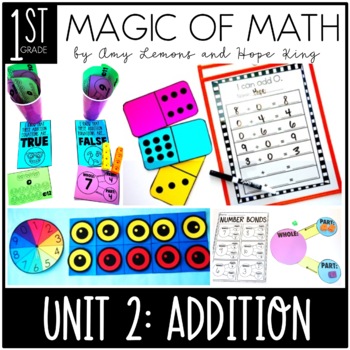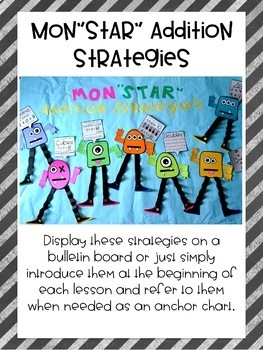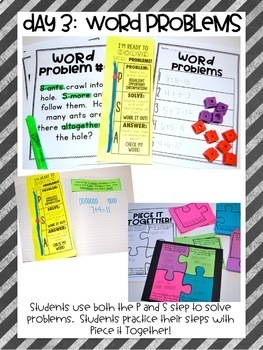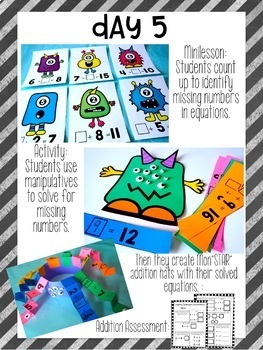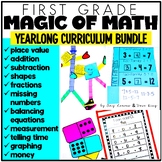1st Grade Magic of Math Lesson Plans for Addition
- Zip
What educators are saying
Also included in
- First Grade Magic of Math curriculum is a series of hands-on math units for teachers who are ready to spruce up their math block! The math bundle features a full year of math lesson plans, activities, games, vocabulary, word problems, and everything else you could possibly need to teach 1st-grade maPrice $123.30Original Price $138.55Save $15.25
Description
Are you ready to introduce addition to your first graders with engaging lesson plans and hands-on addition activities, games, and printables? You're in luck! This complete addition unit helps teach addition strategies using anchor charts, posters, word problems, fact practice, and much more!
The Magic Of Math Unit 2 for FIRST GRADE focuses on:
Week 1 Intro to Addition
Week 2: Addition Strategies
Week 3: Addition Strategies
Week 4: Addition Word Problems and Fact Practice
*Please Note: This is an INTRODUCTION to Addition. We will be focusing on Addition again in Unit 5. We will dig much deeper into addition in Unit 10.
First Grade Math
1st Grade BUNDLE: 1st Grade Magic of Math
For Other 1st Grade Units Click Below:
1st Grade Magic of Math Unit One: Place Value
1st Grade Magic of Math Unit Two: Addition
1st Grade Magic of Math Unit Three: Subtraction
1st Grade Magic of Math Unit Four: Shapes and Fractions
1st Grade Magic of Math Unit Five: Mid-Year Mix Up
1st Grade Magic of Math Unit Six: Nonstandard Measurement
1st Grade Magic of Math Unit Seven: Telling Time
1st Grade Magic of Math Unit Eight: Graphing
1st Grade Magic of Math Unit Nine: Money
1st Grade Magic of Math Unit Ten: Addition and Subtraction
1st Grade Magic of Math Unit Eleven: End of the Year Review
1st Grade Overview 1st Grade Magic of Math Overview and Organization
Here's what to expect from this month long unit for 1st grade:
-Daily Lesson Plans for 20 days
-Aligned with the 1st Grade Common Core and TEKS
-20 Word Problems for each day that complement the skills
-Interactive Notebook Printables and Independent Works
-Games, Activities, and Crafts to enhance learning
-Minilessons with ideas on how to teach the skills as well as materials needed
-Vocabulary Cards
-I Can Statements
-Assessments
-Anchor Chart and Pocket Chart Materials
Want a Closer Look? Here are some (not all!) activities included:
- Addition Anchor Chart
- I Can Add Numbers Students Work Mat
- Grab and Go Addition Game
- Adding Numbers Printable
- Adding Numbers Flap-ups
- Part Part Whole Number Bond Chart
- Number Bond Cards
- Number Bond Work Mat for Students
- Number Bond Printables
- Number Bond Matching
- Spin to Join
- I Can Add to a Set Work Mat
- Fill Up the Fishbowl Game
- Join and Add Printable
- The Dino Stomp Minilesson
- Dino Feet Word Problem
- Dino Domino Dash Interactive Notebook
- True or False Group Activity
- Addition Bracelets and Find a Friend
- Intro to Addition Assessment
- Mon"Star" addition bulletin board
- Adding Zero Domino Scoot
- Adding Zero Interactive Notebook or Printable
- Counting On With Cubes Lesson
- Counting On Number Line Scroll
- I Can Count On Activity
- Giant Number Line Counting On Activity
- Musical Math: Counting On
- Number Line Interactive Notebooks
- Giant Making Tens Ten Frame Activity and lesson
- Spin for 10 activity (finding the missing addend)
- Ways to Make 10 with missing addends activity
- Addition Strategies Assessment
- Doubles Group Sort
- Double! Double! Monster Teeth game
- Interactive Notebooks: Doubles
- Doubles with missing addends
- Mystery Numbers (whole group game)
- Monster Mash: missing numbers BINGO
- Printable: Missing Doubles
- Doubles Plus One Charts
- Double Trouble Game (doubles plus one)
- Interactive Notebooks: Doubles Plus One
- Add addends in any order whole group game
- Flip Flop Activity
- Missing Numbers in Equations Activity
- Monster Add
- Addition Assessment
- PSA bulletin board materials (problem-solving strategy)
- PSA folder templates
- PSA slider
- Plus Pal: Addition Keywords
- Plus Pal Hat
- Problem-Solving: Understanding what the problem is asking
- Over 25 word problems for students to solve
- Add and Cover (differentiated)
- Learning how to read and solve word problems
- Word Problem Solving Mat
- Ninja Kicks Addition Game (differentiated)
- Piece It Together: Word Problem Activity
- Swim to the Top (addition game)
- Problem-Solving: Learning how to check answers
- The Checker: checking problem ideas
- Sunny Sums (differentiated addition game)
- Word Problem Assessment
- Addition Tic Tac Toe (differentiated)
What is the Magic of Math?
The Magic of Math is a series of math lesson plans and activities that can be used as your math curriculum or as a supplement to the program that you are already using. We provide daily lesson plans, word problems, mini-lesson, activities, and interactive notebook entries for four weeks at a time. If you don't have time for it all, that's okay too! You can just pick and choose the pieces that you want to incorporate into your math block!
Are these activities repeated in other units you have?
Absolutely NOT! We create all new activities for each Magic of Math unit. They are all unique to this purchase and are not copied/pasted from things we have previously made.
What is the difference between Magic of Math and other units you have?
Magic of Math is organized as daily lesson plans with everything you need rather than just activities.
WHAT IT IS NOT:
It is NOT a collection of worksheets. Instead, we use games, hands-on activities, engaging mini-lessons, and interactive notebooks to build our curriculum. We do try to keep in mind the amount of prep that is involved with the lessons, but some things will need to be printed, cut, and put together to use in your classroom.
Want to know more about Magic of Math? You can find a blog post about it HERE!

